
It is true, Australia has some of the most venomous spiders in the world! Many visitors to our shores have been more than a little worried about their fearsome reputation. It is wise to be on your guard and keep far away from them.
Spider venom contains a cocktail of chemicals, some of which can be harmful to humans yet of course often fatal for tiny creatures.
Spiders only bite humans as a defence mechanism and are not really their intended victims! The good news is that most spider bites are harmless giving minor symptoms, including itching and rashes. However, some spider bites can cause serious harm and require immediate first aid with emergency treatment and hospital observation. If you do get bitten, ring the Poisons Info Hotline 13 11 26 for assistance.

Spiders are the most widely distributed venomous creatures in Australia with around 10.000 species. Here are the most venomous and scary spiders to watch out for in Australia: –
1. Sydney Funnel-Web

The Sydney Funnel-web has highly toxic venom and large fangs to inject it into its victim. It is one of the world’s most deadly spiders and the deadliest spider in Australia. Funnel-web spiders can be quite aggressive when threatened and rear up showing their fangs. Their bites, when coming from a male, are extremely toxic and can cause the human nervous system to shut down and alter the functioning of all organs, resulting in death. Fortunately, since the antivenom has been made available, in 1981, no fatalities have been recorded.
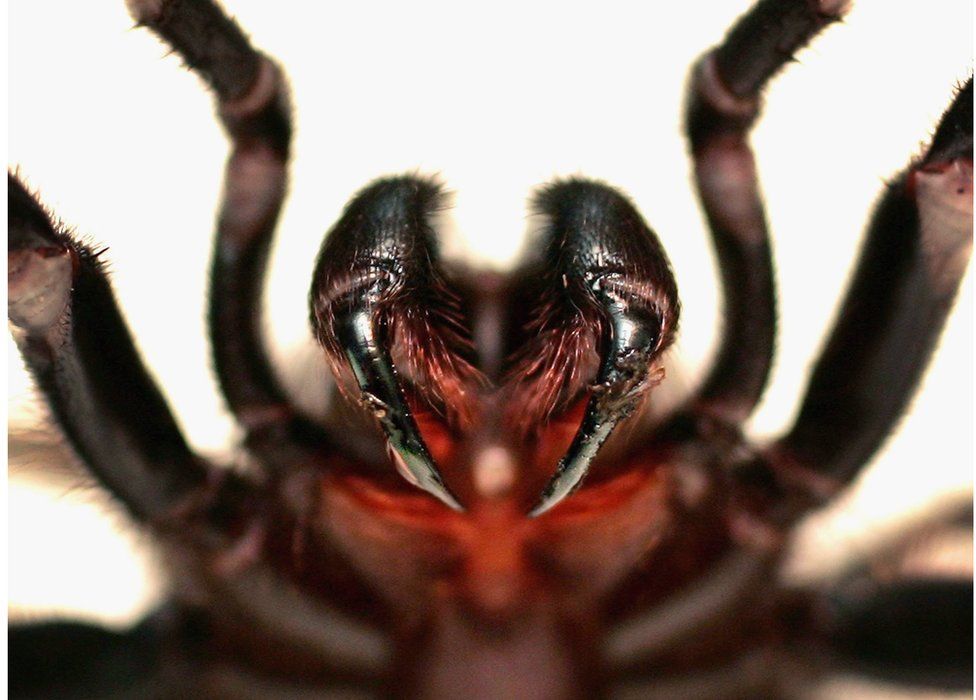
Though just 1.5-3.5cm in size, the Sydney Funnel-web has fangs larger than a brown snake and so powerful they can pierce through fingers and toenails. They are found in New South Wales, in forests and populated urban areas. Feeding on prey ranging from beetles to frogs they are generally more active in the warmer months between November and March. They burrow in humid sheltered places and are known to enter homes and garages when looking for a mate. They can hide out in shoes or fall into swimming pools and if found you should exercise extreme caution as they are more likely to attack than run away!
2. Redback spider

The Redback Spider is highly venomous with a distinctive red stripe on its body. The more serious bite comes from the female Redback Spider who is bigger than the males and measures about 1cm long. Their venom affects the nervous system, but their small fangs make many of their bites ineffective as they are unable to penetrate the skin. The main system if bitten badly is severe and persistent pain, which can last for many hours, nausea, and lethargy.

They are found throughout Australia and like to find little nooks and crannies in urban environments and bushland. They often make a home out of sheltered, quiet places such as anything left lying around in the garden or garden shed. They could even be found in a mailbox or even under toilet seats!
Numbers of redback spider bites are uncertain, but about 2000 are reported each year and about 250 people receive antivenom. Luckily, no deaths have been recorded since redback antivenom became available in the 1950s.
3. Mouse Spider

There are eight species of the Mouse Spider and are considered one of the most lethal spiders as their venom is like that of a Funnel-web. They are often mistaken for the Funnel -web Spider but can be distinguished by their pronounced compact squat and bodies and huge fang sheaths at the front of their head area. There have been no fatalities linked to their bites and the Funnel-web antivenom is the most effective.

The Mouse Spiders are found across Australia typically in burrows near rivers or waterways and occasionally can be found in suburban areas. They are mostly sedentary, and the females tend to stay in their burrows whilst the male spiders wander around in search of them. Unlike other nocturnal spiders who prefer the temperature at night and avoid the heat of the day as well as avoiding the day active predators, Mouse spiders frequently roam around in the daytime heat seeking out their prey.
4. Wolf Spider
These spiders can deliver a painful bite because of their exceptionally large fangs. The bite is poisonous but not lethal. Although non-aggressive, they do bite if provoked and should be considered dangerous to humans There have been reported cases of dizziness, rapid pulse, and nausea. Luckily, most cases report symptoms can include minor local pain or itchiness like a bee sting. If bitten the bite should be cleaned and watched for signs of infection. First aid and medical attention should be sought especially as to children or the elderly.

Wolf Spiders are avid hunters and have excellent eyesight to hunt prey at night. They are a common feature in Australia and are often found in suburbia, where they hide in silk lined burrows and can be found in homes. As ground dwellers, they can be spotted in damp places in the sun and are often covered in leaf litter.
The name Wolf Spider was taken from that fact that people mistakenly thought they hunted in groups like wolves. They are really a shy species that hide in burrows and are ground dwellers. Ranging widely in both size and colour, usually brown, grey, black, or tan with dark markings, most commonly stripes. They hunt insects and have been known to hunt toads or even skate on water and dive under the surface for small fish. They are thought of as a vagrant spider and move from place to place in every variety of terrestrial habitats.
5. Trap-Door Spider

A Trap-Door Spider can stand up and present its fangs if agitated. The bite of a Trap-Door Spiders is not toxic to humans but can be painful and inflict localised pain, nausea, lethargy, and discomfort. Their appearance makes them often mistaken for Funnel-web spiders and the early effects of their bites are similar.
They are brown to dark brown in colour and are heavily covered in fine hairs. The males are known to be more aggressive and bite more than the distinctly larger females. Measuring 1.5- 3.5cm long, the males are identified by having boxing glove shaped appendages which are its sensory feelers at the front of their head While most spiders live only for a year or two, trap-door spiders can live between 5 and 20 years.

Nesting in drier exposed locations, these spiders are named after their habit because they camouflage the entrance of their burrow to trick their prey into falling inside. They are often found in drier open areas around the home.
6. White-tailed Spider

The bite of a White-tailed spider causes no major danger to humans but can cause nausea and a burning pain, followed by swelling and itchiness around the bite. The media have reported that White-tailed spiders have been thought to release flesh eating venom and cause skin ulcers, similar gangrene. Recent scientific studies have been inconclusive and shown that bacterial infection of the wound by the bacteria carried on the fangs of the white tail spider may be this a contributing factor.

The white-tailed spider is named after the distinctive white stripe on the end of their tail which ranges from red to grey to black in colour with dark orange banded legs. The adult varies in size from 12 to 20mm in body length. White-tailed spiders are hunters and wander about at night in both natural and urban landscapes, preferring cool moist locations like garden mulch. In summer they can be found escaping the heat in buildings and especially bathrooms. They like to spend time in folded fabrics, so shaking your towels and sheets before you use them is a good idea! They are nomadic arachnids and hunt at night in search of food, often other less powerful spiders. Although they are native.
7. Black House Spider
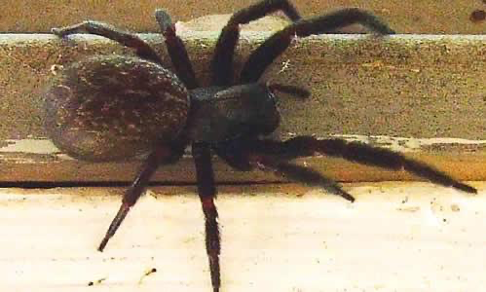
The bite of a Black House Spider is poisonous but not sufficient to cause death. The bite is described as excruciatingly painful around the bite site. Other symptoms are sweating, muscular pains, vomiting, nausea, and dizziness. Some people have a mild necrosis, which is when body tissue dies because too little blood flows to the tissue causing skin lesions. If these serious symptoms appear medical attention must be sought quickly.
The Black House Spider is found to live mostly indoors throughout Australia. They are a dark robust spider has a black velvet appearance with a dorsal pattern of white markings. As an adult they can measure 15mm long with a leg span of up to 30mm, the female is larger than the male never leaves her web unless forced to do so.
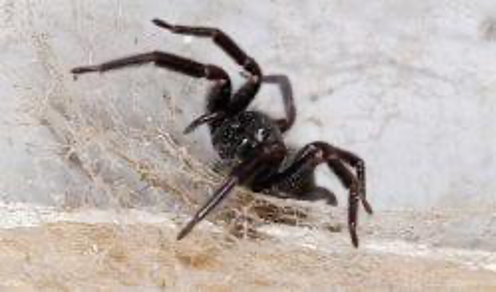
They are found in dry habitats in hidden places, in window frames, under eaves, gutters, brickwork, toilets and in between rocks or bark. They build untidy tangled webs with funnel like entrances. The female constantly repairs the web so giving an old web a grey, woolly appearance from the constant additions of silk (that can often become quite messy and extensive) with a funnel-like retreat and wait for their prey to arrive. Their prey is attracted by electric lights, which catch moths, mosquitoes, flies, and other insects.
8. Common Garden Orb Weaver Spider
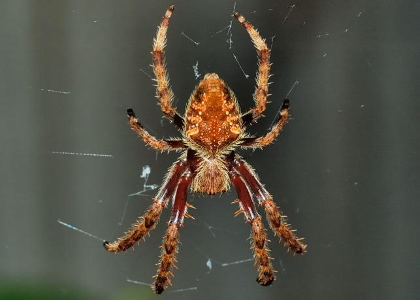
The bite of the Common Garden Orb is feared by many people and is the most reported spider bite each year. They give a nasty sting and are overly aggressive. Fortunately, they have low levels of venom which results in low levels of pain. Although the surprise of walking into and getting tangled in their huge web, particularly at night, is enough to cause panic and get the heart racing!
The adult is between 2-3cm long and has a purplish bulbous abdomen which is often colourful with a dark to light brown pattern, and their body is covered in fine hairs.
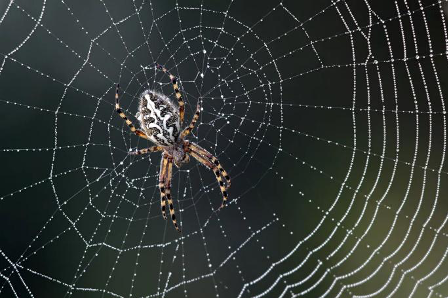
Found in summer in household gardens amongst the flowers and shrubbery. They weave their large circular webs between trees, on hedges and even on washing lines in fact in places where insects are likely to fly and get caught in their sticky threads. During the day they rest with their legs drawn up under their body and are found hanging off a thread under a leaf or even in clothes which are hanging from the line. They come out at night to recover their prey from having mistakenly flown into their web.
9. Huntsman Spider
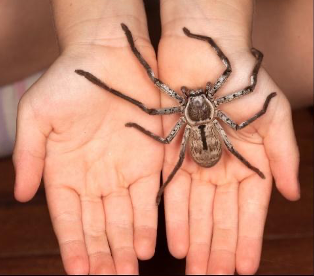
Huntsman spiders are famed throughout Australia for their big, scary, and hairy look! While a large huntsman can inflict a painful bite, their venom is low risk and not considered deadly to humans. More damage can be done by the Huntsman causing a person to have a knee jerk reaction in fright of seeing them. They are well known for sprinting out from behind a curtain and they have even been known to cause car accidents when sprinting out from behind a sun visor or dashboard of a car, surprising a gullible driver! They are not inclined to bite as they are timid, shy spiders and more likely to rapidly run away when disturbed. Beware of the female spider in the summer though when she is guarding her eggs!
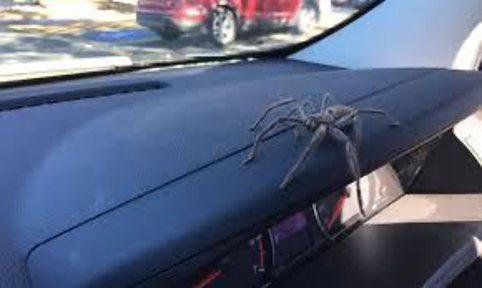
The adult’s body length can be up to 25mm with a diameter of adult including the legs of up to 45mm. They are a yellowish beige to brown in colour with dark patches on their body. They are found under bark of trees, flat rocks, under eaves, within roof spaces, and wandering around home. Despite their intimidating size Huntsman spiders can be a friend in the house as they help with pest control and reduce the level of insects in a home.
10. Recluse Spider
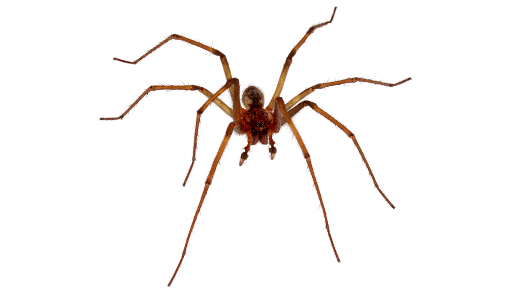
Also known as a Fiddleback Spider, the Recluse Spider has potentially dangerous venom that can be hemotoxic (destroy red blood cells), damaging both the skin and blood. They are known to only have tiny fangs to inject their venom and are not inclined to bite.
The recluse spider is infamous for the flesh-eating properties of its venom that has gained widespread attention. Their bites can leave large areas of skin and flesh destroyed. The injuries are slow to heal and skin-grafts are sometimes needed to aid the healing process. In some of the worst cases, limbs have had to be amputated.
The Recluse Spider is not known to be aggressive and very rarely bites. Their small fangs limit their ability to give out venom, so most bites usually leave mild symptoms. The Recluse Spider has been the cause for many deaths around the world, but none have been reported in Australia, but you are still cautioned to be wary!
